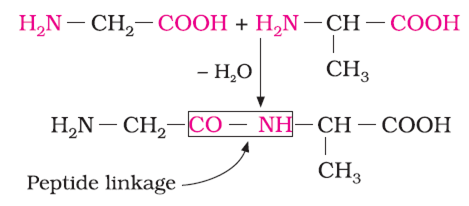 Short Answer Type
Short Answer Type Long Answer Type
Long Answer TypeDefine the following as related to proteins:
(i) Peptide linkage (ii) Primary structure (iii) Denaturation.
i) Peptide linkage: In peptide linkage amide formed between -COOH groups of one molecule of an amino acid and -NH2 group of another molecule of the amino acid by the elimination of a water molecules.
(ii) Primary structure: The primary structure of protein refers to the specific sequence in which various amino acids are present in it, i.e., the sequence of linkages between amino acids in a polypeptide chain. The sequence in which amino acids are arranged is different in each protein. A change in the sequence creates a different protein.
(iii) In a biological system, a protein is found to have a unique 3-dimensional structure and a unique biological activity. In such a situation, the protein is called native protein. However, when the native protein is subjected to physical changes such as change in temperature or chemical changes such as change in pH, its H-bonds are disturbed. This disturbance unfolds the globules and uncoils the helix. As a result, the protein loses its biological activity. This loss of biological activity by the protein is called denaturation.
During denaturation, the secondary and the tertiary structures of the protein get destroyed, but the primary structure remains unaltered. One of the examples of denaturation of proteins is the coagulation of egg white when an egg is boiled.
 Short Answer Type
Short Answer TypeHow are vitamins classified? Name the vitamin responsible for the coagulation of blood.
